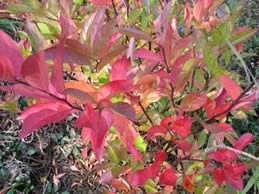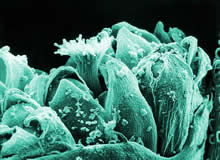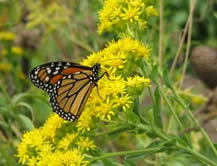|
Our sponsors
The Plantsmen Nursery
The greatest diversity of native plants and other items of interest to habitat gardeners
Growing Wild Perennials
Maple Hill Nursery
Phoenix Flower Farm
Wild Birds Unlimited
|
|
Thank yous!
|
| Thank you to Alice Aylesworth, Ronda Tambasco, Carol Biesmeyer, and John Allen who helped staff our NYS Fair booth last weekend. |
|
Your garden has a function
|
In
the past we have not designed
gardens that play a critical ecological role in the landscape, but we must
do
so in the future. The importance of our doing this cannot be
overstated.
We need to quickly replace unnecessary lawn with densely planted
woodlots in
the East and West, and natural prairies in the Midwest; whatever can
serve as
habitat for our local biodiversity.
Homeowners can do this by
planting the borders of their properties with plants native to their
region: In
the East, native trees such as white oaks (Quercus alba), black
willows (Salix
nigra), red maples (Acer rubrum), green ashes (Fraxinus
pennsylvanica), black walnuts (Juglans nigra), river
birches (Betula
nigra) and shagbark hickories (Carya ovata), under-planted
with
woodies like serviceberry (Amelanchier canadensis), arrowwood (Viburnum
dentatum), hazelnut (Corylus americanus), and blueberries (Vaccinium
spp).
Our studies have shown that even modest increases in the
native plant
cover on suburban properties significantly increases the number and
species of
breeding birds, including birds of conservation concern.
~ Doug Tallamy from Gardening for Life article published in Wild Ones Journal
|
|
Simplify Your Life
|
Another local group, Living Green, Living Good, will co-sponsor with Liverpool Library the Northwest Earth Institute discussion course called Voluntary Simplicity. Here's more information on the course and readings. The group starts on Sat. Sept. 19, 10:30 - 12:00, and continues for 5 weeks. The manual of readings costs $22
(couples are invited to share a book), payable at the first meeting.
To register, go to the Liverpool Library calendar of events and click on the Sept. 19 course to register online. |
|
Greetings!
Alas, summer is winding down. But a habitat garden provides habitat all year long, so there's always something of interest.
Fall is a great time to plant, and so we're again hosting a plant sale - including trees and shrubs that are so important for supporting biodiversity.
Fall is also the time for the start of our regular monthly programs, which include a mix of "big idea" programs and nitty-gritty how-to programs. All are free and open to the public. Come and bring a friend!
Janet Allen,
President, Habitat Gardening in Central New York
|
|
Annual HGCNY Native Plant Sale
This sale has two purposes: first, to raise money to fund our programs, and second, to get native plants planted. We rely on HGCNYers to supply most of the plants for this sale, so please donate your extra volunteer seedlings or divisions to our sale.
*** Native plants only, please! *** We'll also have a sweetspire ( Itea virginica) for auction, donated by Larry Keassa from Maple Hill Nursery in Manlius. Itea's fall color is spectacular, and its spring flowers are beautiful, too. Thank you, Larry! You'll have an opportunity to order trees and shrubs potted seedlings, too. Here's the list for you to peruse. Here's the procedure: * Select plants from this list of plants either by mail or at the plant sale. * Give us a check for the order (or mail it to arrive by Saturday). * You'll be notified when the order is in (probably the week of Sept. 20), and you can pick up your purchase at the Allens'.
LOCATION: The Allens - 401 Parsons Dr., Westvale DATE: Saturday September 12, 10:00 am - 12:00 pm. If you're bringing plants, come at 9:00 am and stay to shop before the crowds arrive at 10! |
|
Sept. 27: "The Significance of Media Images of Nature"
We're pleased to have Dr. Mark Meisner as our first speaker this year. Dr. Meisner, Assistant Professor of Environmental
Communication at SUNY-ESF will discuss and illustrate some of the
key ways that the natural world is portrayed through the media. These
include Nature as a problem, Nature as a resource, and Nature as a
victim or patient. The implications of these and other such
representations of Nature will be discussed in relation to how Nature
is perceived, valued and treated in North American culture.
Dr. Meisner directs the Environmental Communication Network and
edits Indications, the Environmental Communication and Culture blog. DATE: Sunday, Sept. 27 at 2:00 pm at Le Moyne College. SPECIAL NOTE: Although our programs usually take place in the Library's Special Activities Room, this month it will take place in the Coyne Science Center in Room 227. Here are the detailed campus directions and a map.Our meetings are free and open to the public. Please join us! |
|
|
The scoop on Monarchs and their journey
 Besides being beautiful, the monarch fascinates people because this small insect completes a long journey to Mexico, a place the individual butterfly has never before seen. How does it do it? [The monarch here is pictured nectaring on Liatris ligulistylus] Besides being beautiful, the monarch fascinates people because this small insect completes a long journey to Mexico, a place the individual butterfly has never before seen. How does it do it? [The monarch here is pictured nectaring on Liatris ligulistylus]
Scientists don't have all the answers, but you'll definitely learn a lot about this remarkable journey from the website Journey North. And if you're a teacher, you'll also find a wealth of top-quality science activity materials for your students.
Besides interesting background info, there are weekly updates on the journey south. Here's an excerpt from Sept. 3: "Spectacular roosts were reported in Nebraska this week. With tens of thousands
of butterflies, they were the largest yet of the season. Both roosts were
found beside blooming alfalfa fields, a welcome source of nectar for migrating
monarchs who are traveling through a sea of cropland. Early arrivals continue
to be reported from the south."
You could peruse these FAQ about monarchs for hours! It's a wealth of information about monarch characteristics, life cycle, ecology, and conservation. And these answers are all supplied by prominent scientists who specialize in monarchs.
And don't miss out by thinking you're too old to look at the "For Kids" section. It includes information, videos, and more that will interest adults, too. For example, see if you can figure out this amazing "Mystery Photo."
And when you've satisfied your curiosity about monarchs, check out the sections on hummingbirds and other migratory creatures.
|
|
Achoo!
 You may indeed be sneezing, but please don't blame it on goldenrod! The idea that goldenrod causes allergies is a myth - a myth that dies hard it seems.
You may indeed be sneezing, but please don't blame it on goldenrod! The idea that goldenrod causes allergies is a myth - a myth that dies hard it seems.
More likely, ragweed (Ambrosia) is to blame. It often grows in areas where goldenrod is growing, though, so which plant do you notice when you start sneezing? The showy goldenrod, of course, not the nondescript ragweed.
Plants such as ragweed are wind-pollinated, not insect-pollinated
as is goldenrod. Wind-pollinated plants need huge quantities of
lightweight pollen to ensure pollination - and some of this pollen is
bound to reach your nose.
Goldenrod and other insect-pollinated plants have smaller
quantities of heavy, sticky pollen - all that's necessary to get
pollinated by insects, but not to reach your nose.
Ragweed (Ambrosia)~From Wikipedia
From the Centers for Disease Control and Prevention:
 This is a scanning electron micrograph of an Ambrosia trifida plant,
or more commonly known as ragweed. When ragweed pollen is disbursed, many
people have a reaction, but because they don't see the tiny flowers on
the ragweed, they assume it's the pollen from the larger flowered
goldenrod, which blooms at the same time. Note the dispersed pollen
granules. This is a scanning electron micrograph of an Ambrosia trifida plant,
or more commonly known as ragweed. When ragweed pollen is disbursed, many
people have a reaction, but because they don't see the tiny flowers on
the ragweed, they assume it's the pollen from the larger flowered
goldenrod, which blooms at the same time. Note the dispersed pollen
granules.
Some beautiful goldenrods
Insects and butterflies will thank you for planting at least one of these nectar-rich goldenrods (Solidago). Here are just two of the many garden-worthy species:
 This is a monarch enjoying nectar from stiff goldenrod (Solidago rigida), one of many species of garden-worthy goldenrod. This is a monarch enjoying nectar from stiff goldenrod (Solidago rigida), one of many species of garden-worthy goldenrod.
 This is the appropriately named cultivar of Soldago rugosa called 'Fireworks.' This is the appropriately named cultivar of Soldago rugosa called 'Fireworks.'
|
|
|
|
|